Last updated: 25 December 2001
|
Last updated: 25 December 2001 |
Some ETX users have sent me examples of their astrophotography. If you have some examples you would like included here please send me a description of how you made the astrophotos and a copy of the images as GIF or JPEG files (due to internet email gateway issues, please send only one image file per message). Send to etx@me.com. Alternatively, if you have created your own web page with your examples please let me know and I'll include a link to your site.
| vincent_ysc1@yahoo.com (chan sing) [25 Dec 01] |
|---|
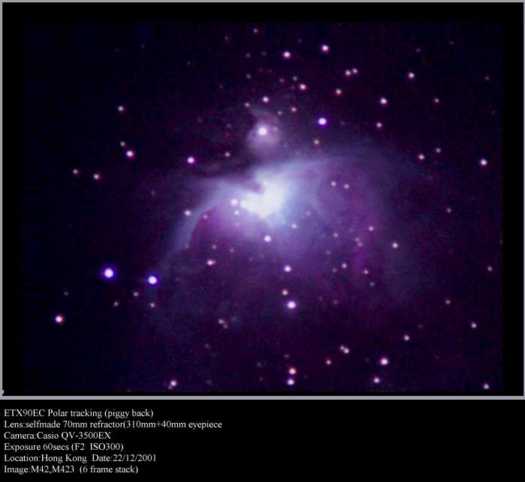 |
|
Attach photo was used selfmade 70mm
refractor(disassembly from binocular)+40mm
eyepiece.mount on ETX90EC,polar tracking.used casio
QV-3500 digital camera,ISO 300,exposure 60sec.3X
zoom.used astrostack and photoshop edit.6 frame stack.
|
| stankiewiczr@cogeco.ca (Rick Stankiewicz) [23 Nov 01] |
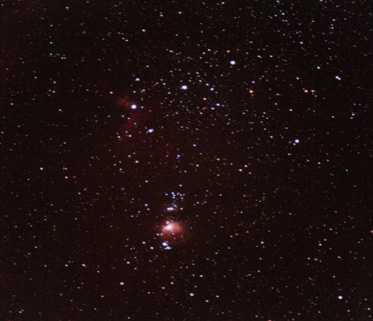 |
|
I the best shot that I have yet
of M42 and 43 that same morning (no Leonid though). I can see the Horsehead
Nebula on the original picture! It was a 2 minute exposure on 1,000 Kodak
Royal film and I used a Canon Ftb camera with a Canon 135mm lense @ f/2.8.
I piggy backed on my ETX. I guess I had it aligned okay that morning?
|
| ulrich.schilder@t-online.de (Ulrich Schilder) [13 Nov 01] |
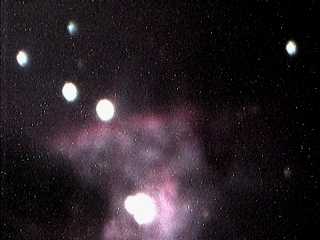 |
|
I often visit your website, because i find there a lot of useful things
about the ETX-125. Some weeks ago i saw the deep sky-guest gallery on
your website. Up to that time i thought that was impossible with that
teleskope. That was wrong! Inspirated from these pictures i have also my
webcam modified.(See it also on http://home.clara.net/smunch (a lot of
thanks to Steve chambers for his Software "Desire" and his good
modification-report!) The picture from M42 was my first deep-sky picture
with a webcam and the ETX-125. It was exposured for 40 seconds with the
software "Desire" and a modified Phillips PCVC 675k webcam on the
10.11.2001 at 01:00am , near the City Bielefeld/Germany. At this time,
the only modification with this picture was made with MS Photo Editor
and the function "Auto-Balancing". I am very proud about my first
deep-sky picture! More pictures and tips about my ETX-125 you will found
on my homepage: http://home.t-online.de/home/ulrich.schilder Sorry about
my homepage, but it's only in german. (I hope also my english was not to
bad.)
Best regards and clear sky's |
| rs@stepperequipment.com (bob sharpe) [24 Oct 01] |
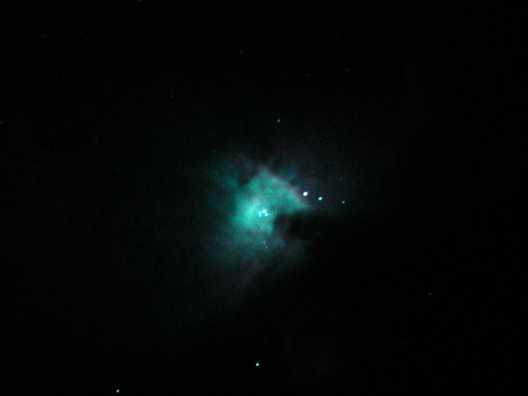
|
|
I recently purchased the Lumicon deep sky filter to use with the etx125ec, and the olympus C3040 digital camera. By freezing the camera for about 10 minutes, in conjunction with the Deep sky filter, I was able to eliminate just about all the noise the CCD generated while taking the attached photo of M42 during 3 sixteen second exposures and 1 two second exposure
Telescope Equipment ETX-125EC @ Prime focus Scopetronix F6.3 focal reducer SAC IV eyepiece projection hardware for Olympus C3040 camera Lumicon 1 1/4" Deep Sky Filter Digital Enhancements Corel photopaint 10.0 used for all enhancements. 3 nebula pix had dark frame subtract each, with "brightness" of darkframe pixels adjusted to match noise level for each picture before subtraction. 3 nebula pix merged as objects using "if lighter" setting Stars removed from merged nebula picture using "clone" tool and "mask cut" tool Star picture merged with nebula pix resulting in minimal star trailing. Camera Details Olympus C3040Z in manual mode 3X optical + 2X digital zoomed for focal length of 151mm Nebula: 3 pictures @ 16 sec shutter speed 400 ISO each using lumicon deep sky filter, Stars: 1 picture @ 2 sec shutter speed 400 ISO using lumicon deep sky filter Manual focus, set to infinity, remote control shutter release Super High Quality mode @ 2048 x 1536 for all pix Camera "frozen" in freezer for 10 minutes before 3 nebula shots. 1 minute "defrosting" of lens using fan upon immediate removal from freezer. 1 minute delay between each nebula shot to allow ccd to cool down somewhat... I created 2 pix, one showing what the nebula looks like through the eyepiece, and one showing the end results of all of the enhancements listed above.. Thanks to the guy on your site who had the idea of freezing the camera before exposure. It makes a world of difference. Hopefully there are no long term effects on the camera. I am using it for normal stuff also, and have not noticed any degredation of image quality! [Top] This attached image is what the ccd imaged, with no color manipulation, just stacking 3 nebula images with one star image. [Bottom] heres the same pix of m42, as I viewed it through the eyepiece! In photopaint I set the nebula transparancy to 30%, and adjusted the colors to simulate a green haze.... This image attached to this email has the stars image at 100% opaqueness, and the nebula at 30% opaqueness, or 70% transparency. I also colored the nebula a little more green, to simulate what I saw in the 26mm eyepiece.... The reason I tried to make a photo of m42, exactly the way I saw it in the eyepiece, was to get some baseline of what the capability of the etx125 was, in relation to other scopes. Before purchasing the ETX, (which is my first scope), I spent a lot of time searching the web, looking for this type of scope comparison data. I could not find any site that compared scopes by showing images of the same object, at the same magnification. I am surprised that this type of data doesn't exist. It would be a great asset to anyone contemplating purchasing a new scope. Do you know of any site that compares scopes this way? |
| GERALD_WECHSELBERGER@at.ibm.com (Gerald Wechselberger) [3 Oct 01] |
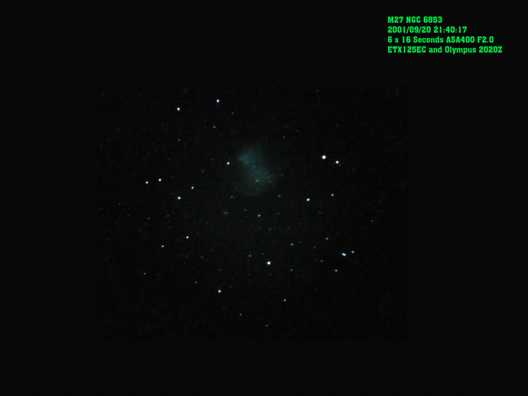 |
|
On September 20th this year i tried to picture the Planetary Nebula M27
with my ETX125EC.
I used the Olympus 2020Z which i cooled simply between the shoots in the
deep freezer for 6 minutes to
minimize thermal noise which came up at air temperature of more than 13
Degree Celsius!!
The final Picture was stacked out of 6 times 16 seconds exposures with 26
mm(!) Eyepiece projection - No guiding
was necessary as the ETX in polar mode is running smoothly keeping the
stars in place. Darkframe subtraction was done.
I think the ETX together with a Digitalcamera like the 2020Z Olympus is a
good combination which allows
easy Planetary, Lunar, Solar AND Deep Sky imaging for only a small
fraction of the price of other combinations.
Feel free to put this image on your guest ETX-Page.
Thanks for putting interesting information about the ETX issue all time
update. Its always very interesting and useful
to browse your pages!
|
| sgrijalva@yahoo.com (Saul Grijalva V.) [22 Sep 01] |
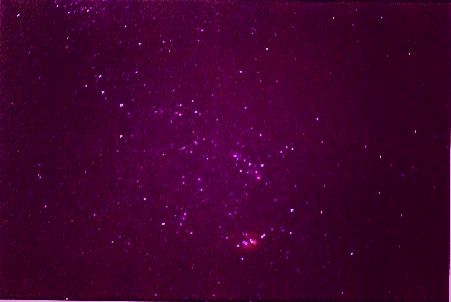 |
|
Here is a picture of M8 the Lagoon Nebula. I took it with a Minolta camera
200mm lens at f/4.5 piggybacked on my ETX-90. Exposure was 10 minutes on
Kodak color film ASA 800.
Greetings from Mexico,
|
| igrodroch@enlace.net (Ignacio Rodriguez) [08 Sep 01] |
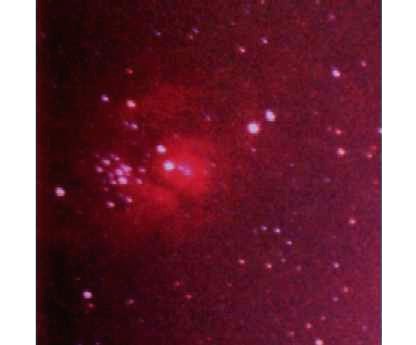 |
This is a photo of M8, Lagoon Nebula. This is the result of a new set up I am testing. I use a scopetronix piggyback adapter, an Olympus OM-1n and a Vivitar 500 mm lens. I guide with the ETX125 and a 12mm Meade guiding eyepiece. I'm including a photo of this set-up.
The film is Kodak SUPRA 400 (which has good sensitivity for red ) and the exposure was 15 min. the Vivitar lens is f/8. This mirror lens is a very good lens because it has a very compact size, is not heavy and is inexpensive.
The image was scanned from the print in a flatbed Canon scanner. The lens covers 5 degrees, the amplified section is 30 min aprox. There are 12 magnitude stars in the photo so I think it is a nice result taking into account that the photo was taken in the city from my light polluted backyard.
I also have a Celestron Radial guider and I'm waiting a SC adapter I order from Shutan to make a test taking this same photo in prime focus with the ETX125.
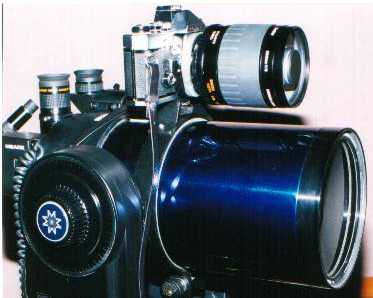
|
| erwin@matys.co.at (Erwin Matys) [31 Aug 01] |
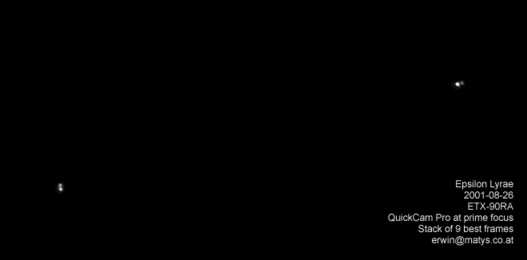 |
|
on a night of superb seeing i managed to image
epsilon lyraes split components.
Many thanks to Colin Bownes for his superb
capturing software VEGA. It turns a cheap
WebCam into a really powerful imaging tool.
|
| vergot@adelphia.net (Adrian Vergot) [31 Aug 01] |
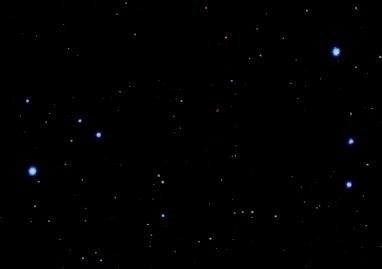 |
|
It was one of those extremely rare clear nights in the 'burgh, so I pulled
out the ETX70. As per my last contributions to the photo gallery, I like
pushing the limits of the ETX70 lense at prime focus instead of simply
using the scope to piggyback a camera. Like my previous two entries in the
photo gallery this one was at prime focus, but instead I opted to polar
align. You are looking at a ~2 minute exposure of the base of Lyra. This
photo, taken on Fuji Superia X-Tra 800, reaches up into magnitude 11. If
one knows their star map, they can see that this picked up the ring nebula.
I also found on your site the quick and dirty way of polar aligning by just
clicking on "ok" during the two star aligning (without accurately centering)
even if the scope is not aligned, and then fine tuning it by syncing after
the fact. I can't say it enough, but thanks once again for a GREAT site.
|
| CJones@online-can.com (Jones, Clive) [13 Jun 01] |
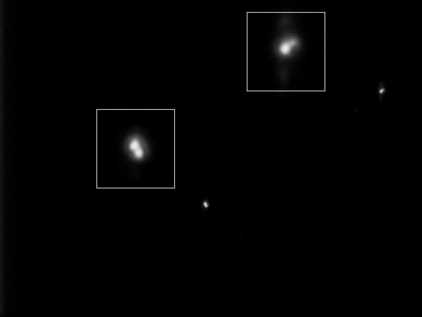
|
|
I have included some photographs that I hope you will feel that some of them
are worthy of inclusion on your website.
[Top] Eps Lyra - Epsilon Lyra - Taken with an ETX125 and a QuickCam pro. Processing is with AstroStack. The two pairs are separated by 209.3" (according to Autostar). The star top right (e1) has a separation of 2.6" and the bottom left (e2) by 2.3" arc seconds. e1 magnitudes 5.0 and 6.1; e2 magnitudes 5.2 and 5.5. June 9th, 2001 [Bottom] Albireo - Beta Cygni - Taken with an ETX125 and a QuickCam pro. Processing is with AstroStack. Shows the blue companion very nicely compared to the brighter yellow star. Picture was taken at prime focus and the separation is 34.7". June 9th, 2001 Clive Jones (Winnipeg, MB) |
| Christian@cpccenter.com (Christian Cummings) [28 Mar 01] |
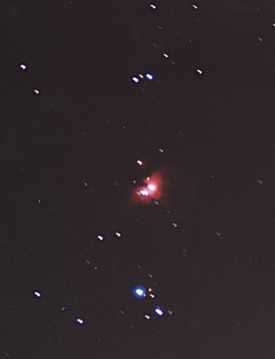 |
|
Have been reading your site since we purchased an ETX60 for Christmas. It has been a great help to me and my family in learning how to get the most out of this new hobby. Trying to capture the beautiful things that I can see with scope on film has been a challenge. I am looking to purchase a new scope with more aperture but for now I am having a lot of fun with the challenge of capturing a good image from the ETX60. Sunday night I had a good night and wanted to share the picture with you so you could show that the ETX60 is capable of good things too. :-)
The attached picture was taken 03/26/01 around 9 o'clock with an Olympus OM1 (with a 2x teleconverter using Polaroid 400 film) attached to an EXT60 at primefocus via the T adapter. The mirror was locked up and the exposure was for about 5-7 minutes roughly guided though the Meade #827 8x25 right angle finder scope. The scope is attached to the standard tripod with a custom wedge that I made from an example that you have on your web site. The negatives were developed at Wolf Camera and the picture was scanned into PhotoShop to apply an unsharp mask.
Thanks for the great site.
|
| nunosilva2000@yahoo.com.br (Nuno Miguel de Freitas Silva) [25 Mar 01] |
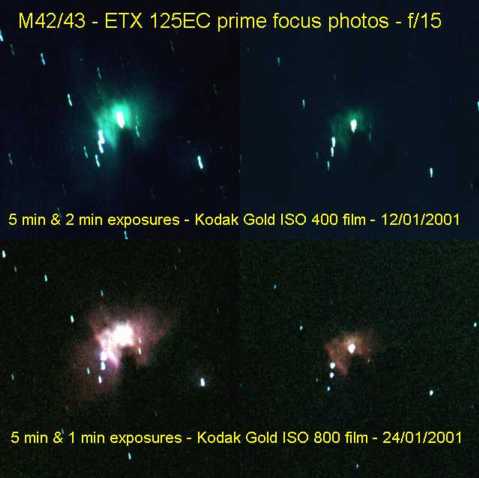 |
|
Here are some interesting photos of M42 i took before
i had my etx repaired. Note that the nebula has a
different appearance when photographed with different
films. I believe that greenish tone seen in the 400
ISO film is due to the OIII line emission while the
800 ISO film captured mainly the red H-alpha
radiation.
Diferent details can be seen in the two films. There
was no image processing except for adjusting
brightness and contrast.
All photos were taken with the etx 125ec at polar
mount with the original electronic controller traking
at sideral speed. No guiding.
|
| gerald_wechselberger@at.ibm.com (Gerald Wechselberger) [12 Mar 01] |
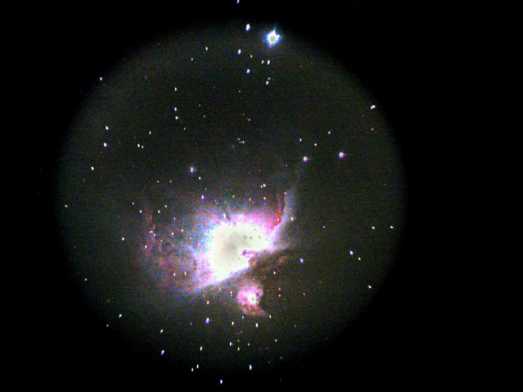
|
|
[Top] Please find attached a CCD picture of the Orion Nebula M42 from December
23rd 2000.
Pictured with an Olympus Digitalcamera Z2020 attached to the ETX 125EC with
40mm eyepiece projection, NO GUIDING!
The picture is made out of 6 'darkframe subtracted' images stacked with
Micrografix Publisher , all 6 images have been exposed 16 Seconds each at
400 ASA .
[Bottom] Please find attached a CCD picture of the Open Cluster M67 from February 14th 2001. Pictured with an Olympus Digitalcamera Z2020 attached to the ETX 125EC with 40mm eyepiece projection, NO GUIDING! The picture is made out of 4 'darkframe subtracted' images stacked with Micrografix Publisher , all 4 images have been exposed 16 Seconds each at 400 ASA . (Funny thing is i just found a Color Slide picture which i made in March 1981 with my old 8 inch Dynamax which shows with 40 Minutes exposure time less details than the 5 inch ETX with 64 seconds exposure.) Feel free to put this image on your guest ETX-Page. Thanks for keeping the ETX issue all time update. Its always very interesting and useful! |
| nunosilva2000@yahoo.com.br (Nuno Miguel de Freitas Silva) [16 Feb 01] |
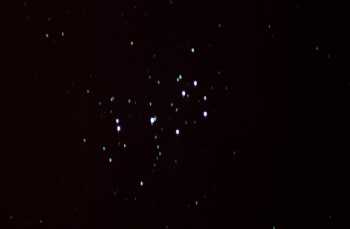 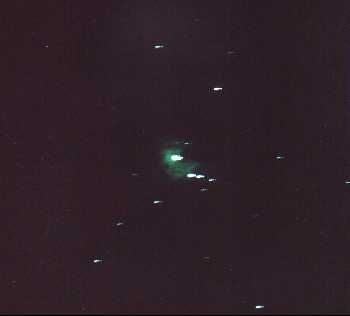 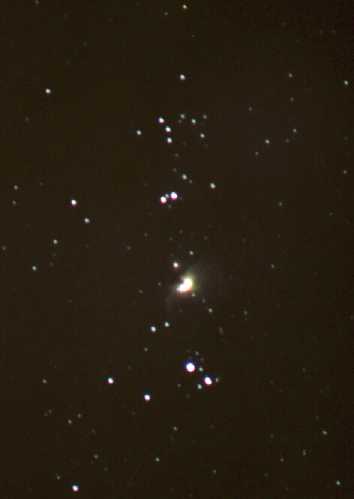 |
|
Take a look at these deep sky photos i took in
January, before that problem in the RA drive i had
with my etx 125ec.
You will notice that my piggy back M45 shot is much
better that the one i first e-mailed you. Here is the
photos data:
[Top] M45 - piggy back Nikon 300mm f/5 zoom lens on etx 125ec, polar mount with RA motor on, roughly guided 22 minute exposure, ISO-400 kodak film; [Middle] M42 - etx 125ec, polar mount with RA motor on, prime focus 2 minute exposure, no guiding, ISO-400 kodak film; [Bottom] M42 - piggy back Nikon 300mm f/5 zoom lens on etx 125ec, polar mount with RA motor on, roughly guided 10 minute exposure, ISO-400 kodak film. |
| rjkrejci@earthlink.net (Rick Krejci) [16 Feb 01] |
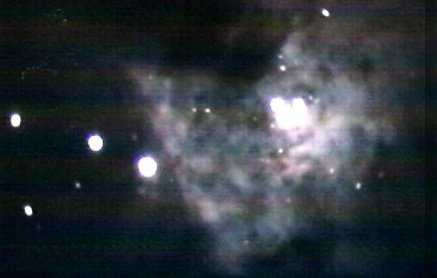 |
|
Taken with a LX90 8". Commentary and more are available at my new web site,
which I'm officially declaring "done enough" if you would like to add it to
your links. It also contains my comparisons of the 2 scopes (ETX-90/LX-90)
and a bunch of other stuff. It's at:
home.earthlink.net/~rjkrejci/
Thanks for providing me inspiration and knowledge with your great web site!
|
| gerald_wechselberger@at.ibm.com (Gerald Wechselberger) [13 Feb 01] |
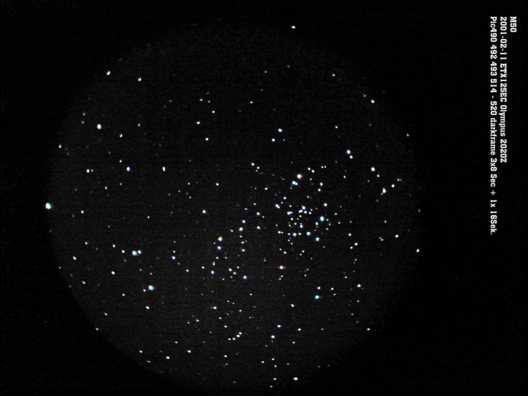 |
|
Please find attached a CCD picture of the Open Cluster M50 from February
11th 2001.
Pictured with an Olympus Digital camera Z2020 attached to the ETX-125EC with
40mm eyepiece projection, NO GUIDING!
At relative low outside temperature(0C) the Olympus showed only very small
thermal noise and was easy to handle on the ETX for other deep sky images
too. (more to come)
The picture is made out of 5 'darkframe subtracted' images stacked with
Micrografix Publisher , 2 images have been exposed 16 Seconds at 400 ASA
and 3 with 8 Seconds..
Feel free to put this image on your guest ETX-Page. Thanks for keeping the
ETX issue all time update. Its always very interesting and useful!
|
| henrykzels@t-online.de (H. Zels) [13 Feb 01] |
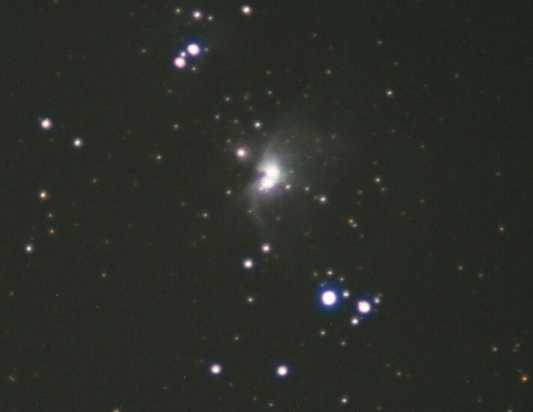 |
|
please find attached a picture that shows why we should NOT use Fuji Superia
100ASA Films (with the "4th colour layer") for deep sky photography. I've
tested a focal length doubler for my Nikon F3 (with a Nikkor 135mm/2,8) and
tried the great orion nebula again (this time with a ILLUMINATED guiding EP
in my ETX90EC). Unfortunately the used Film doesn't show any color in the
nebula although the nebula itself is good to see. The entire Picture is very
bright (exposed about 20 minutes) even it was taken with a f5,6 - lens
(135mm/f2,8 + doubler = 270mm/f5,6). So the Fuji S100 has a very little
"Schwarzschild - coefficient" (but not for all colors). I have taken some
shots of the moon with this film too and i'm really NOT satisfied with the
results (mainly because of really false colours). Maybe thats a great film
for daylight / short - time - exposures. But for deep sky - long time
exposures you will have more fun with b&w - films :(
But hey, its only a test and we (at least i) have learned something.
|
| vergot@adelphia.net (vergot erin) [10 Feb 01] |
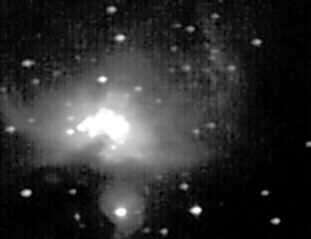 |
|
Hello again from Pittsburgh, PA.... The worlds worst location to be into
astro-photography. We haven't had a clear night in over a month and a
half. Yesterday, we finally get a clear one, but due to the almost full
moon, any hope of astrophotography through the 7" Mak was out. Sooooo, I
dragged out my ETX-70AT to see how it could perform in a "worst case"
scenario. The attached CCD image of M42 was taken at prime focus of the
ETX-70AT in Alt-Az configuration, two star aligned. This was taken with
SBIG's low end CCD camera, the ST5C, and is a track-and-accumulate of three
10 second exposures which totals 30 seconds. Now, notice the size of the
image..... an ST5C is an array of 320 by 240 pixels. This capture is at
311 by 239.... that means that the ETX only drifted 9 pixels in the X-axis,
and only 1 pixel in the Y-axis throughout the 30 second exposure. Since
this and M13 came out fairly well (considering -grin-), I've started up a
page of Messier captures through this little scope.....
http://compsci.duq.edu/~vergot/astronomy/etx70deepsky/etx.htm On the down side, the Flame and Horsehead nebulas were utter failures.... then again, I can barely spot these items on a clear moonless night through my 7" Mak, so it really was an unfair test..... -Adrian |
| henrykzels@t-online.de (Henry Zels) [31 Jan 01] |
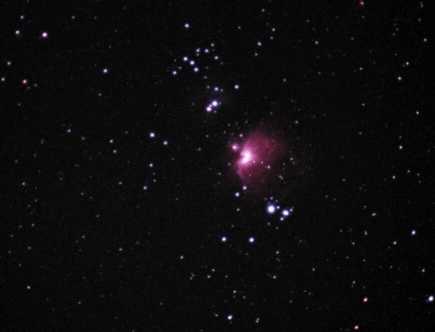 |
|
finally, i got a guiding - eyepiece. Unfortunally, the illumination of the
crosshair doesn't work yet so i can only guide if the fov has a bright
background. The attached pic of the great orion nebula shows an first try.
piggybacked Nikon F3, 135 mm/ f2,8, exposure 15 minutes on AGFA HDC 200
(guided thru my ETX90EC, 12mm MEADE illuminated EP without Illumination)
keep up your great site and clear skies to all |
| rjkrejci@earthlink.net (Rick Krejci) [27 Jan 01] |
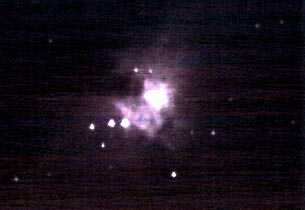 |
|
I thought I'd include this in your gallery. I thought it turned out nice for a webcam (QC VC) shot on an etx90. I used astrostack to stack about 30 shots of Orion and used Photoshop to minimize some noise and get a good balance. Some noise is still very apparent, but it was a fairly warm evening (50F) here in Scottsdale. I used Jim Berry's idea of using the viewfinder objective as a field widener..helped a great deal. I strictly use a Telrad for finding objects now.
Thanks for all your work! Rick Krejci |
| vergot@adelphia.net (Adrian Vergot) [21 Jan 01] |
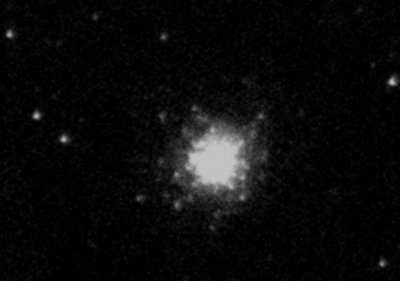 |
|
Attached is a CCD photo taken through the ETX/70 in alt-az mode using two
star alignment. This was using an SBIG ST5C (their low end CCD) with
tracknaccumulate of five five-second exposures for a total of ~25
seconds. Not too shabby for a poor little ETX -grin-. This was a
"quickie" test shot, so imaging what could be gotten if I had the scope in
polar align mode, fine tuned aligned, well focused, and even a halfway
working autoguiding! If interested, I'll keep you up to date on my
progress. Once again, thanks for a great site.
|
| henrykzels@t-online.de (Henry Zels) [21 Jan 01] |
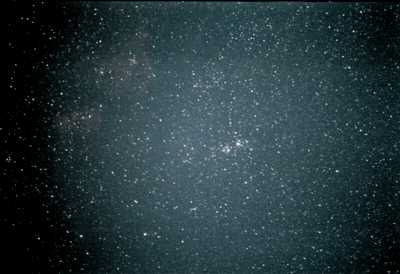 |
|
please find attached a picture of the "double cluster". Take with a
Nikon F3, 135 mm/f2,8 - Lens, AGFA HDC 100. Exposure about 15 minutes. The
camera was mounted on a JMI Piggyback on my ETX90EC. I've done some
guiding (with the 26 mm SuperPloessl, unfortunally i don't have a really
guiding - eypiece yet) but its very rough. [Mike here: I adjusted the levels a little bit to reduce the sky background brightness]
I'm hopefully looking forward to read some tests of the SAC-IVc - integrating software at your site soon :). If anybody has this tested yet, please let me know. |
| nunosilva2000@yahoo.com.br [16 Jan 01] |
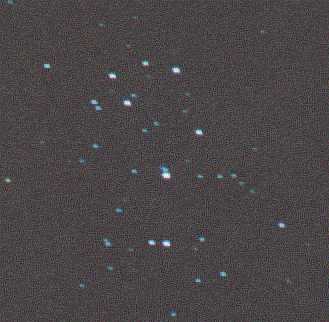 |
|
M45: etx-125ec, polar mount with RA motor on, piggy back 300mm f/5 zoom lens, 12 minute exposure, 400 asa film, roughtly guided.
|
| jahorsley@hotmail.com (John A.Horsley) [4 Jan 01] |
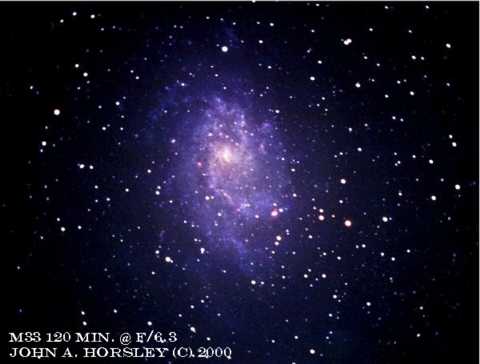 |
|
Well the last time I e-mailed you an image was the 80 minute auto-guided exposure of NGC7000. (North American Nebula) I have since achieved longer guides with my ETX90mm and 201xt autoguider. The set up works excellent for me. Here is a 120 minute auto-guided exposure of M33. I am really pleased with the performance of the ETX and 201xt. Now that I am confident with the set up and guider I can now start researching Filters, and Hypersensitized films.
Mike here: Several questions have been raised on the above photo. John is using the ETX as a Guide Scope on his 8" LX200. Here is a description of his setup (from the April 2000 Feedback page): Subject: ETX 201xt combo. Sent: Tuesday, April 25, 2000 19:40:41 From: jahorsley@uswest.net (John A. Horsley) I just wanted to update you on my ETX set up. I've taken my ETX-90/ra off it's mount and have placed it in it's new home a top my 8" f/10 LX200 with the help of a Losmandy's DR125 3 point rings & DM8 dovetail plate. (I tell you this $2000 + upgrade really helps the tracking and Go To's of the ETX's ;-) I am using the ETX now as a guide scope in conjunction with a Meade 201xt autoguider and a Meade 4000 series 9mm illuminated ep. The ETX works great for this application, utilizing the ETX's built in flip mirror. Attaching the 201xt at prime focus and the 9mm ep in visual port. (To attach the 201 to the prime focus I used an Orion LAR adapter and a Meade SCT 1.25" visual back.) The ETX is parfocal at both visual ports, and so happens the 9mm illuminated and 201xt are parfocal too. It's as though this application was meant to be. Using the 201xt can be frustrating at first with having to find center of the CCD chip, to attain focus, finding the proper exposure time and calibrating, but with practice it becomes... dare I say easier??? No! Lets just say less frustrating. Once you get everything working, the results are.... Well here is a pic I shot last night of M13. This 30 minute exposure shot on Kodak Portra 400 ISO, guided with the ETX and 201xt. (DON'T USE THIS FILM FOR ASTROPHOTOGRAPHY IT SUCKS!!!! The photo lab that does my processing gave me the roll to try. So I tried it... I hate it!) All in all I really like this set up, and it's nice not having to guide by hand! I've still to guide for longer than 30 minutes. Which I hope I can give you the results of hour + guiding soon. I'll let you know how it comes out. Clear Skies -n- Keep Lookin UP.... John "The Church says the Earth is flat, but I know that it is round. For I have seen the shadow on the Moon, and I have more faith in a shadow than in the Church." (Ferdinand Magellan) Support Science Not Superstitions! 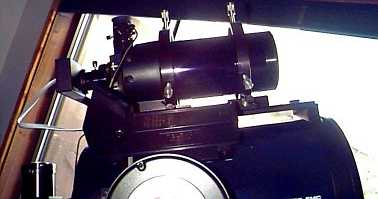
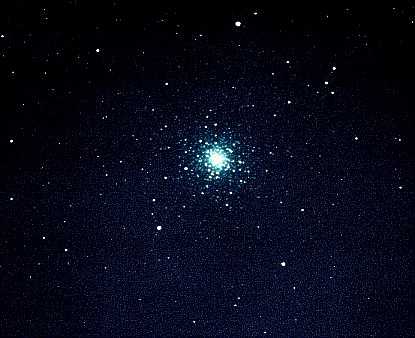
|
See the Guest Deep Sky Archive 2000 for photos posted in 2000.
See the Guest Deep Sky Archive 1999 for photos taken 1999 and earlier.
Return to the top of this page.
Go back to my ETX Home Page.